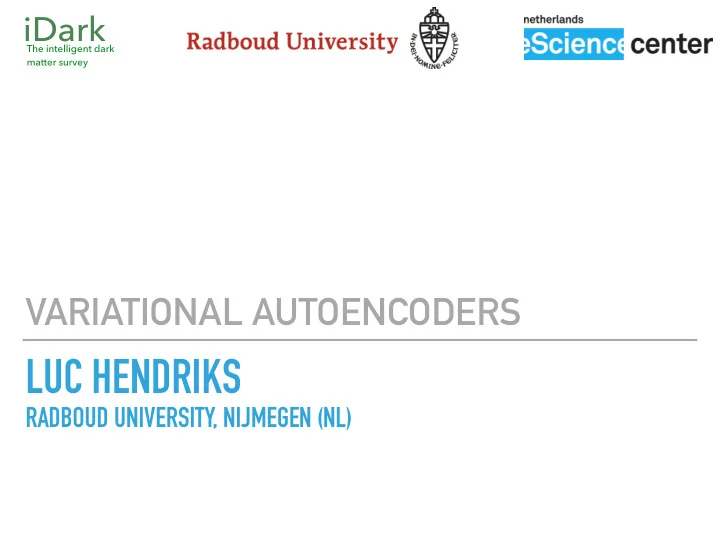

iDark � 1 The intelligent dark matter survey VARIATIONAL AUTOENCODERS LUC HENDRIKS RADBOUD UNIVERSITY, NIJMEGEN (NL)
VARIATIONAL AUTOENCODERS � 2 ▸ Conceptual talk about VAEs ▸ VAEs as a tool to do: ▸ Anomaly / outlier detection ▸ Noise reduction ▸ Generative modelling ▸ Event generation with a density buffer (Sydney’s talk)
VARIATIONAL AUTOENCODERS � 3 ▸ Conceptual talk about VAEs ▸ VAEs as a tool to do: ▸ Anomaly / outlier detection ▸ Noise reduction ▸ Generative modelling ▸ Event generation with a density buffer (Sydney’s talk) ▸ Topics ▸ Normal AEs ▸ The concept of latent spaces ▸ VAEs ▸ β -VAEs
AUTOENCODERS � 4 ▸ Class of deep learning algorithms ▸ Output = input ▸ Unsupervised learning (no labels needed)
AUTOENCODERS � 5 ▸ Class of deep learning algorithms ▸ Output = input ▸ Unsupervised learning (no labels needed)
AUTOENCODERS � 6 ▸ Class of deep learning algorithms ▸ Output = input ▸ Unsupervised learning (no labels needed)
AUTOENCODERS � 7 ▸ Reconstruction very good —> compression algorithm ▸ Noise reduction ▸ Outlier detection: ▸ Put in something that the AE never saw —> bad reconstruction ▸ Reconstruction loss = variable for outlier detection
AUTOENCODERS � 8 ▸ Outlier: credit card fraud detection No fraud Fraud Reconstruction loss Reconstruction loss
AUTOENCODERS � 9 ▸ Outlier: credit card fraud detection No fraud Fraud Reconstruction loss Reconstruction loss ▸ Noise reduction: MNIST noisy
AUTOENCODERS � 10 ▸ No ordering in latent space Assume 2D easy viz.
AUTOENCODERS � 11 ▸ No ordering in latent space Assume 2D easy viz. Latent dim 2 Latent dim 1
AUTOENCODERS � 12 ▸ Input slightly different than training set —> reconstruction loss high, because latent space is ill-defined there ▸ Not robust ▸ What is between the data points? ? ?
AUTOENCODERS � 13 ▸ If only the points could be grouped together… ▸ Unsupervised clustering, interpolation between data points … 0 2
VARIATIONAL AUTOENCODERS � 14
VAE � 15 ▸ Force ordering in latent space ▸ During training, you are minimising some loss function ▸ For regression (normal AE): MSE( output - input )
VAE � 16 ▸ Force ordering in latent space ▸ During training, you are minimising some loss function ▸ For regression (normal AE): MSE( output - input ) ▸ Add KL-divergence term: Σ i KL( 𝓞 ( μ i , σ i ), 𝓞 (0,1)) := KL( μ , σ ) ▸ So 𝓜 = MSE( output - input ) + KL( μ , σ )
VAE � 17 ▸ The KL divergence punishes latent space values far away from the center ▸ Also, every point has a variance that is pushed to 1 ▸ Balance MSE and KL —> group similar structures around the center while keeping RL in check
LATENT SPACE � 18 ▸ Same example, but now a VAE
VAE � 19 ▸ Balancing MSE and KL is tricky ▸ Balance using another hyperparameter β ▸ 𝓜 = (1- β ) * MSE( output - input ) + β * KL( μ , σ ) ▸ β -VAE β Avg var Avg mean 1 1 1.89E-09 5E-01 0.99999905 2.35E-07 5E-02 0.86448085 … 5E-03 0.554529 5E-04 0.3784553 5E-05 0.09676677 5E-06 0.008932933 0 0.0000442
VAE � 20 ▸ Use the latent space and decoder as generative model\ ▸ Explore the latent space! PCA on the latent variables
PLAYING WITH LATENT SPACES � 21 ▸ Train VAE on face images ▸ Change the latent space variables
PLAYING WITH LATENT SPACES � 22 ▸ Or 3D objects
PLAYING WITH LATENT SPACES � 23 ▸ Or 3D objects ▸ Latent space = abstract representation of your data ▸ Encoder maps input to gaussians in latent space = Gaussian mixture —> you can do lots of stuff
CONCLUSION � 24 Teaser :) ▸ VAEs can be used for ▸ Outlier / anomaly detection ▸ Noise reduction ▸ Generative modelling ▸ Data compression ▸ Exploration of latent space can give very interesting applications — event generation, hybrid models, density estimation, …
Recommend
More recommend